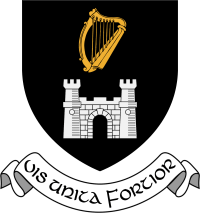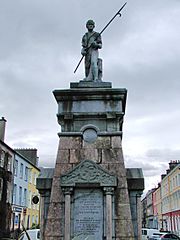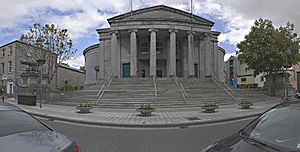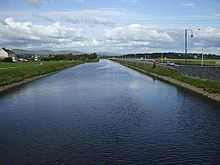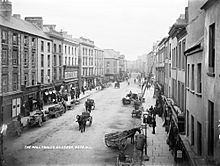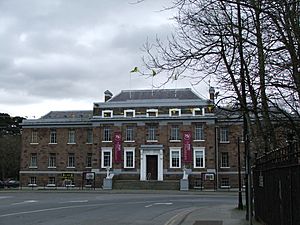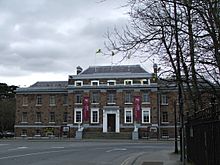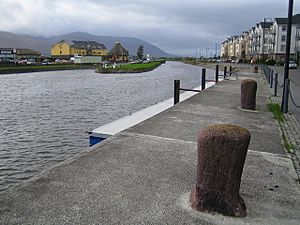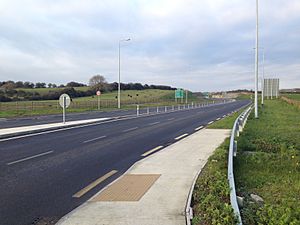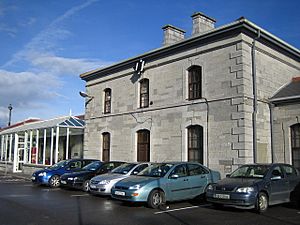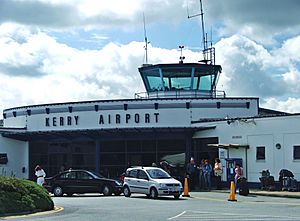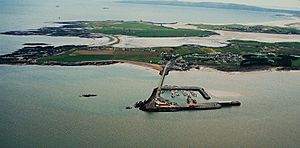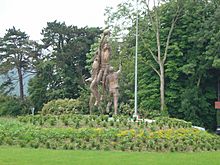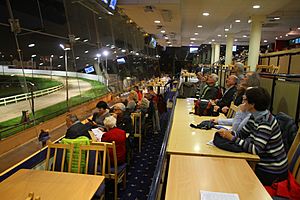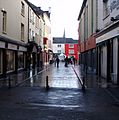Tralee facts for kids
Quick facts for kids
Tralee
Trá Lí
|
||
|---|---|---|
|
Town
|
||
|
|
||
|
||
| Motto(s): | ||
| Country | Ireland | |
| Province | Munster | |
| County | Kerry | |
| Elevation | 37 m (121 ft) | |
| Population
(2022)
|
26,079 | |
| • Rank | 15th | |
| • Density | 739.2/km2 (1,915/sq mi) | |
| Time zone | UTC±0 (WET) | |
| • Summer (DST) | UTC+1 (IST) | |
| Eircode routing key |
V92
|
|
| Telephone area code | +353(0)66 | |
| Irish Grid Reference | Q828141 | |
Tralee (pronounced trə-LEE) is the main town of County Kerry in the south-west of Ireland. Its Irish name, Trá Lí, means 'strand of the River Lee'. The town is located on the northern side of the Dingle Peninsula. It is the largest town in County Kerry, with a population of 26,079 people as of 2022. Tralee is famous for the Rose of Tralee International Festival, which happens every August.
Contents
- Tralee's Past: A Journey Through History
- Tralee's Climate
- Fun Places to Visit in Tralee
- The Rose of Tralee Festival
- Ancient Sites Around Tralee
- Local Media
- Getting Around Tralee: Transport Links
- Healthcare in Tralee
- Learning in Tralee: Schools and University
- Sports in Tralee
- Famous People from Tralee
- Tralee's Twin Towns
- Gallery
- See also
Tralee's Past: A Journey Through History
Tralee was built where several small rivers meet, near marshy land at the top of Tralee Bay. It sits at the start of an old road that goes south over the Slieve Mish Mountains. Along this old path, you can find a large rock called Scotia's Grave, which people believe is where an ancient queen was buried.
How Tralee Began
Anglo-Normans founded Tralee in the 13th century. It became a strong base for the Earls of Desmond, who built Tralee Castle. In 1260, John Fitz-Thomas FitzGerald started a Dominican monastery here. The town was burned down in 1580 because of the Desmond Rebellions against Queen Elizabeth I.
In 1587, Queen Elizabeth I gave Tralee to Edward Denny. The town was officially recognized in 1613 by a Royal Charter. The Denny family played a big role in Tralee's development. The modern layout of Tralee, with its wide streets, was created in the 1800s. Denny Street, a beautiful Georgian street, was finished in 1826.
Monuments and Buildings
A monument to the 1798 rebellion and other uprisings stands on Denny Street. It's a statue of a Pikeman, a soldier with a long spear. The original statue was destroyed in 1921 during the Irish War of Independence, but a new one was put up in 1939.
Tralee Courthouse was built in 1834. It has a monument with two cannons, remembering Kerrymen who died in the Crimean War (1854–56) and the Indian Rebellion (1857).
The Tralee Ship Canal
The Tralee Ship Canal was built so larger ships could reach Tralee. The old quay in Blennerville was getting blocked by silt. Work on the canal started in 1832 and it opened in 1846. It was 2 miles long and had a new basin in Tralee.
However, the canal also started to get blocked by silt. By the 1880s, Fenit Harbour was built as a deeper port that didn't have this problem. A railway line was built to connect Fenit Harbour to Tralee, moving goods from ships. The canal eventually stopped being used. In the 1990s, after Blennerville Windmill was restored, the canal was also restored for tourists. Today, the path along the canal is a popular walking route.
Times of Conflict
Tralee experienced a lot of fighting during the Irish War of Independence and Irish Civil War between 1919 and 1923. In November 1920, the Black and Tans (a British police force) surrounded Tralee. They did this to get revenge after two of their men were taken and killed by the Irish Republican Army (IRA). The Black and Tans closed all businesses and stopped food from entering the town for a week. They also burned houses and businesses linked to IRA members. These events caused a big international outcry.
| Historical population | ||
|---|---|---|
| Year | Pop. | ±% |
| 1821 | 7,547 | — |
| 1831 | 9,568 | +26.8% |
| 1841 | 11,363 | +18.8% |
| 1851 | 9,445 | −16.9% |
| 1861 | 10,271 | +8.7% |
| 1871 | 9,506 | −7.4% |
| 1881 | 9,910 | +4.2% |
| 1891 | 9,318 | −6.0% |
| 1901 | 9,867 | +5.9% |
| 1911 | 10,300 | +4.4% |
| 1926 | 10,533 | +2.3% |
| 1936 | 10,285 | −2.4% |
| 1946 | 9,990 | −2.9% |
| 1951 | 11,045 | +10.6% |
| 1956 | 11,612 | +5.1% |
| 1961 | 11,423 | −1.6% |
| 1966 | 11,976 | +4.8% |
| 1971 | 13,263 | +10.7% |
| 1981 | 17,035 | +28.4% |
| 1986 | 17,620 | +3.4% |
| 1991 | 17,862 | +1.4% |
| 1996 | 19,950 | +11.7% |
| 2002 | 21,987 | +10.2% |
| 2006 | 22,744 | +3.4% |
| 2011 | 23,693 | +4.2% |
| 2016 | 23,691 | −0.0% |
| 2022 | 26,079 | +10.1% |
In August 1922, during the Irish Civil War, Irish Free State troops took Tralee from the Anti-Treaty forces. Later, in March 1923, Free State troops killed nine Anti-Treaty IRA prisoners near Tralee. Only one person survived this event.
The Ashe Memorial Hall was built in 1928 at the end of Denny Street. It remembers Thomas Ashe, an Irish officer from the Easter Rising of 1916. Since 1992, it has been home to the Kerry County Museum. The museum has a cool reconstruction of what Tralee looked like in 1450.
Tralee's Climate
Tralee has a mild and changing climate, like the rest of Ireland. It gets a lot of rain, and temperatures are not extreme. The warmest months are July, August, and September, with temperatures around 17-18 degrees Celsius. The wettest months are October, November, December, and January.
Fun Places to Visit in Tralee
Tralee is a great place for tourists, with many attractions:
- Kerry County Museum: Learn about Kerry's history, including a fun exhibit showing life in medieval Tralee.
- Siamsa Tíre: Ireland's National Folk Theatre, where you can enjoy traditional Irish music and plays.
- Blennerville Windmill: Just 2 km outside town, this is Ireland's largest working windmill.
- Tralee Aquadome: A big indoor water park with a mini-golf course for a splashy good time.
- Ballyseedy Wood: A 32-hectare woodland with walking paths, old ruins, and beautiful trees. The River Lee flows along its northern edge.
- Tralee Town Park: Right in the town centre, this park has a beautiful rose garden with over 5,000 roses. It hosts the annual Féile na mBláth / Tralee Garden Festival.
- Tralee Bay Wetlands and Nature Reserve: This huge nature reserve is home to many birds and wildlife. The Wetlands Centre lets you explore fresh and saltwater habitats and even take a safari boat ride!
- Tralee Ship Canal: This 2-mile-long canal connects Tralee to Tralee Bay. The Dingle Way walking trail runs along its path.
- Dingle Way: A 162 km long walking trail that starts and ends in Tralee. It usually takes about eight days to complete.
- Ratass Church: A very old church from the tenth century, with a sixth-century ogham stone.
The Rose of Tralee Festival
The Rose of Tralee festival is a famous international competition. It's celebrated by Irish communities all over the world. The festival started in 1959 and happens every August. It's inspired by an old song about a beautiful woman named Mary, who was called "The Rose of Tralee." The contest is shown on Irish TV and is watched by over a million people!
To celebrate this tradition, the Rose Garden in Tralee Town Park has a bronze statue of the original Rose of Tralee, Mary O'Connor, and the person who wrote the song, William Pembroke Mulchinock. There's also a "Rose Wall of Honour" with the names of every Rose who has been part of the festival since 1959.
Ancient Sites Around Tralee
There are many old archaeological sites around Tralee and County Kerry. These include ring forts, like Casement's Fort, where Roger Casement once hid. There's also an Iron Age fort at Caherconree, which looks out over Tralee Bay.
You can also find a Sheela na gig (an old stone carving) at the Christian Round Tower in Rattoo, a few kilometres north of Tralee. At Fenit, there's a monument to Saint Brendan the Navigator, with models of ancient Irish buildings.
Local Media
Tralee has two local weekly newspapers, The Kerryman and Kerry's Eye. There are also free weekly papers called Tralee Outlook and Tralee Advertiser.
The town has a local radio station, Radio Kerry, which started in 1990.
Getting Around Tralee: Transport Links
Road Travel
Tralee is connected by important national and local roads. A 13.5 km bypass around Tralee opened in 2013, helping traffic flow better. It connects four main national routes that end in Tralee.
 east/north-east to Limerick
east/north-east to Limerick south-east to Killarney and Cork
south-east to Killarney and Cork north to Listowel and Limerick
north to Listowel and Limerick south-west to Killorglin and Ring of Kerry
south-west to Killorglin and Ring of Kerry west to Dingle
west to Dingle
Bus Services
Tralee's bus station is a main hub for Bus Éireann. You can catch buses to Dublin, Limerick, Galway, Cork, Killarney, and Dingle. Many local bus routes also start from Tralee.
Train Travel
You can take a train from Tralee to Killarney, and then on to Cork and Dublin. There are also connecting trains to Limerick and other towns.
The current Tralee railway station, called Casement station, opened in 1859. There used to be two other train stations in Tralee that are now closed. The Tralee and Dingle Light Railway was a narrow-gauge railway that connected Tralee and Dingle. It closed in 1953, but a small part was reopened in 1993 for tourists. This tourist railway is not currently running.
Air Travel
Kerry Airport is about 20 km from Tralee. It offers flights to Dublin, London, Frankfurt, and seasonal flights to sunny places like Alicante and Faro. You can get a connecting train from Farranfore railway station to Tralee.
Sea Travel
The local port for Tralee is Fenit, about 10 km west of the town. It's a pretty harbour with fishing boats and a marina for smaller boats. The Tralee Ship Canal also connects Tralee directly to the sea.
Healthcare in Tralee
University Hospital Kerry opened in 1984 and is the main hospital for County Kerry. The Bon Secours Hospital is a private hospital that opened in 1921.
Learning in Tralee: Schools and University
Most schools in Tralee are run by churches. These include Roman Catholic schools like CBS and Presentation Primary School, and a Church of Ireland school called St John's. There is also a multidenominational school, Tralee Educate Together School.
For older students, there are secondary schools like Mercy Secondary School, Mounthawk and Presentation Secondary School. There are also non-religious schools like Coláiste Gleann Lí Post Primary School.
At the university level, the Munster Technological University (MTU) is the main higher education place in County Kerry. It started as a college in 1977 and became part of MTU in 2020. About 3,500 students study subjects like business, computing, science, and engineering here.
Sports in Tralee
Gaelic Games
Austin Stack Park is the main Gaelic Athletic Association (GAA) stadium in Tralee. It's named after Austin Stack, a famous Irish revolutionary and football captain. Many Kerry GAA games are played here, including county finals.
There are several GAA clubs in Tralee, like Austin Stacks GAA club, John Mitchels GAA club, and Kerins O'Rahilly's GAA. Tralee Parnells promotes hurling.
Soccer
Tralee is home to Kerry F.C., a professional soccer club formed in 2023. They play at Mounthawk Park. Other local soccer clubs include Tralee Dynamos and St. Brendan's Park F.C.
Other Sports
- Racket Sports: Tralee has a Tennis Club and a Badminton Club.
- Cricket: County Kerry Cricket Club plays at the Oyster Oval in the nearby village of Spa.
- Cycling: There are several cycling clubs in Tralee, like The Chain Gang Cycling Club and Tralee Bicycle Club.
- Basketball: Clubs include St. Brendan's Basketball Club and Tralee Imperials Basketball Club. The Tralee Warriors are a well-known team.
- Golf and Pitch & Putt: Tralee Pitch and Putt Club is located at Collis Sandes House.
- Triathlon: Tralee Triathlon Club is one of the largest in Ireland and hosts an annual triathlon event.
- Watersports: Kingdom Swimming Club, Tralee Bay Sailing Club, and Tralee Bay Swimming Club are active. Tralee Rowing Club is located at the Basin.
- Rugby: Tralee Rugby Football Club has its ground in Ballyard.
- Athletics: Tralee Harriers is the local athletics club.
- Greyhound Racing: Tralee has a greyhound racing stadium.
Famous People from Tralee
- Saint Brendan, a famous saint and explorer, was born near Tralee.
- Kieran Donaghy, a well-known footballer.
- Rea Garvey, singer from the band Reamonn.
- Christie Hennessy, a popular singer/songwriter.
- Úna-Minh Kavanagh, a journalist and author.
- Mikey Sheehy, a legendary footballer.
- Dick Spring, a politician and sportsman.
- Austin Stack, a revolutionary and footballer.
Tralee's Twin Towns
Tralee is twinned with two towns in the United States: Westlake, Ohio, and Springfield, Massachusetts. Tralee also has a twinning arrangement with Beit Sahur in Palestine.
Gallery
-
Tralee from the International Space Station
See also
 In Spanish: Tralee para niños
In Spanish: Tralee para niños






